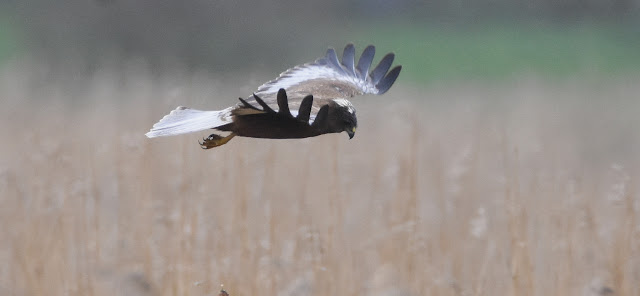The Safari had a day out in north Lancashire with CR last week. We started out at Sizergh Castle where we (as is becoming the norm) dipped the Hawfinches. It didn't help that the place was busy and a couple of gimmers parked next to where C'd dropped the seed bait and faffed around getting their kit out of the back of the car for at least 20 minutes. Very dull cloudy conditions leading to rain didn't help the photography either. A Nuthatch flew in grabbed a sunny seed and bombed straight back in to cover.
But a Chaffinch hung around not flitting far when the faffers were moving around.
Look at its legs and feet, the poor little b*gger has Papilloma virus.
The rain sent us to Leighton Moss where there is shelter from the rain. However the rain had eased a bit and that gave us the opportunity to have a look at the Black Headed Wagtail (144, PYLC #112) that turned up a couple of days earlier.
Just a little too distant given the conditions but a bright little stonker whatever the weather. We've seen them before in Greece but it's a British Isles subspecies lifer for us.
Nothing speaks of spring like the cacophony of a Black Headed Gull colony.
There's always something going on in the melee - plenty of displaying and posturing going onFollowed up by the whole raison d'etre for the whole colony
But look closely and you'll find some odd ones out, interlopers, in the colony.
Avocets are pretty aggressive to other species around their nest sites but they're also quite happy to take advantage of the 'cover' provided by the vigilant Black Headed Gulls for extra protection against marauding larger gulls, crows etc.
One of them did us the honour of coming nice and close.
A flock of Black Tailed Godwits was on the pool too, coming in to their stunning summer plumage too.
Pintail are subtle stunners too.
Back on the reserve proper the Marsh Harriers gave us a great performance including collecting nesting material from a pile of cut reed on the opposite side of the pool. Shame the light was so iffy in the rain so the pics are a bit fuzzy and grainy.
Like the Pintails, Teal are proper little stunners too.On the trails we came across a Marsh Tit
And a Chiffchaff or two.
At the main hide we fluked a drake Garganey (145, PYLC #113) right close to the hide window which unfortunately we later discovered it had already been seen about ten minutes before we 'found' it.
If front of the Garganey there was a Little Egret that C thought looked a bit poorly. It did seem to perk up a bit after a few minutes
We also fluked our best pic of Snipe (PYLC #114) of the year - yes this dross is our best attempt at this fairly common species in the last 3 1/2 months, don't know how we've managed that!
Wandering down to the Causeway hide we completely emptied it by mentioning the Garganey, never has so much birding kit been packed up so quickly! Out of the window there was a good variety of waterbirds present many getting well in to their breeding cycle.
Not quite so far along the line was a flock of Pochards, sadly a rare site these days. mostly randy bachelors chasing after the few females present.
Close up, yet another stunner.
Not a bad day out on safari considering the weather and we did actually remain mostly dry by cleverly dodging the showers and darting between the hides.
Next up was an afternoon up the top of Rossall Tower with the Wildlife Trust's Living Seas team watching for whatever wildlife showed up. A Wheatear decided to fly out across the bay but didn't go far before turning back. Where Wheatears feared to tread a few individual Swallows went willingly as did a small number of Sandwich Terns. Behind us from the golf course we were serenaded continuously by a particularly persistent Skylark. Eventually we found a distant Grey Seal out by the new island which today held only one male Eider with the usual gulls. Towards the close of play we found a second Grey Seal then found what was probably Harbour Porpoise but it never resurfaced to confirm or otherwise.
The following day we had a short jaunt Over Wyre with GB. We were on the hunt for the Water Pipits that have been frequenting a flooded field. Trouble was we'd had a couple of 20C+ days and the flood was shrinking rapidly. The field had lots of Skylarks and some Lapwings, the sound of both our youths. We could only find a single Meadow Pipit on the flood along with a few Shelducks. A Buzzard and a Raven flew over and flushed a load of Black Tailed Godwits of the marsh and a good load of Whimbrel (146, PYLC #115) too.
The warm weather brought out a good number of butterflies too, they were all Small Tortoiseshells though.
In the meantime let us know who's dropping unannounced in in your outback.

































No comments:
Post a Comment